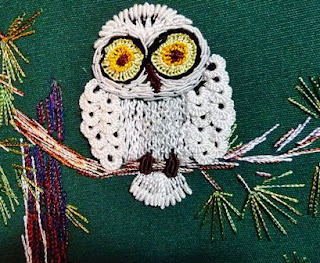Brazilian embroidery is so beautiful, so exquisite, so neat ... and, well ... so DIMENSIONAL --on the front!
This is the back:
Doesn't it look like a can o' colorful worms, singin', dancin' and havin' a party out behind the barn?
It's supposed to look that way!
Traditional embroidery is neatly stitched front and back -- but not Brazilian embroidery, the rambunctious, riotous, colorful Poster Child for the Creative Stitch.
Brazilian dimensional embroidery marches to its own drummer. Brazilian dimensional embroidery has, in fact, a whole band of drummers marching in the direction of their choice, led by a fairly short list of dimensional stitches that are commonly used (and then re-used, re-invented, re-created into new stitch innovations).
The reason I'm shamelessly posting pictures of my behind -- Excuse me! I meant to say the "behind of my embroidery" -- is to let stitchers new to B.E. realize it's OK to worry less about the back of their needlework.
Take a look at the Judging Criteria prepared by the BDEIG Standards Committee. Print this pdf and take it to your County or State Fair Superintendents and ask them to use it to judge Brazilian embroidery entries. Ask them to please not judge the back of the work.
B.E. stitchers just don't worry too much about the back side of their work -- it's the front side that should get all the attention, both in fair judging and in general admiration.
A lot of Brazilian embroidery is stitched on the heavier-thread-count Trigger cloth or Blazer poplin to hide any floss tails that might shadow through. However, there are a lot of other fabrics that lend themselves well to B.E., especially fancy fabrics, and it never hurts to keep the back side of the embroidery as neat as possible -- especially if a stitcher is using a lighter weight fabric.
By the way, even when Trigger cloth or any of the heavier poplin fabrics are used, it's always nice to add a lightweight lining fabric (my choice is 80%-20% poly-cotton blend Symphony Broadcloth). --It's just what I do. Everyone has a personal preference.
Yes, these are pictures of the little Hummy Art Quilt (the backside part we politely aren't supposed to notice). I've just finished all of the leaves and flowers and am busy stitching eyeballs on hummingbirds. I'll post more pictures soon ...and then I'm going to go in search of fabric to finish the edges, sashes and bindings and other quilty things.
This is the back:
Doesn't it look like a can o' colorful worms, singin', dancin' and havin' a party out behind the barn?
It's supposed to look that way!
Traditional embroidery is neatly stitched front and back -- but not Brazilian embroidery, the rambunctious, riotous, colorful Poster Child for the Creative Stitch.
Brazilian dimensional embroidery marches to its own drummer. Brazilian dimensional embroidery has, in fact, a whole band of drummers marching in the direction of their choice, led by a fairly short list of dimensional stitches that are commonly used (and then re-used, re-invented, re-created into new stitch innovations).
The reason I'm shamelessly posting pictures of my behind -- Excuse me! I meant to say the "behind of my embroidery" -- is to let stitchers new to B.E. realize it's OK to worry less about the back of their needlework.
Take a look at the Judging Criteria prepared by the BDEIG Standards Committee. Print this pdf and take it to your County or State Fair Superintendents and ask them to use it to judge Brazilian embroidery entries. Ask them to please not judge the back of the work.
B.E. stitchers just don't worry too much about the back side of their work -- it's the front side that should get all the attention, both in fair judging and in general admiration.
A lot of Brazilian embroidery is stitched on the heavier-thread-count Trigger cloth or Blazer poplin to hide any floss tails that might shadow through. However, there are a lot of other fabrics that lend themselves well to B.E., especially fancy fabrics, and it never hurts to keep the back side of the embroidery as neat as possible -- especially if a stitcher is using a lighter weight fabric.
By the way, even when Trigger cloth or any of the heavier poplin fabrics are used, it's always nice to add a lightweight lining fabric (my choice is 80%-20% poly-cotton blend Symphony Broadcloth). --It's just what I do. Everyone has a personal preference.
Yes, these are pictures of the little Hummy Art Quilt (the backside part we politely aren't supposed to notice). I've just finished all of the leaves and flowers and am busy stitching eyeballs on hummingbirds. I'll post more pictures soon ...and then I'm going to go in search of fabric to finish the edges, sashes and bindings and other quilty things.
































